
O.Symetric Harmonic chainrings - too good to be true?
O.Symetric's Harmonic
chainrings
Photo ©: Greg Johnson
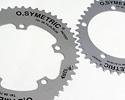
|
|
Want to buy a set?
Photo ©: Greg Johnson
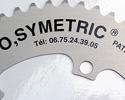
|
|
Installation is mostly
straightforward…
Photo ©: Ben Abrahams
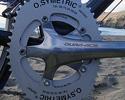
|
|
…but front derailleur
clearance and adjustment can be an issue
Photo ©: Ben Abrahams

|
|
The O.Symetric rings
may not be the most stylish
Photo ©: Ben Abrahams

|
|
The promise of increased power output for the same perceived effort
(or the same power for less effort) sounds like the ideal of every
competitive cyclist, but it's precisely what O.Symetric claims to
offer with its somewhat strange looking chainrings.
The theory behind O.Symetric's rings is a relatively simple one:
the ring's varying diameter alters the effective gear ratio throughout
the pedal stroke, producing a higher gear on the downstroke where
the rider typically has more power, and reducing it thereafter to
accelerate transition between the dead spots. The concept isn't
new (and is now actually growing in popularity), but the O.Symetric
version is decidedly more radical than some other options currently
on the market. The rather large 1.2:1 ovalization factor (the ratio
of largest to smallest diameters) of our 52T tester equates to pushing
a 57T ring through the downstroke and spinning a 47T at the dead
spots. Similarly, our 42T inner ring yields a maximum effective
size of 46T and a minimum of 38T.
Not surprisingly, O.Symetric claims its particular design offers
a significant increase in efficiency over conventional round rings
- specifically, a 5-15 percent increase in power output, which supposedly
corresponds to a three percent increase in speed. Additional benefits,
according to O.Symetric, include reduced knee stress, faster recovery
time and better traction on a mountain bike thanks to a more stable
power output.
The company presents various tests comparing its rings versus conventional
round rings that were conducted both in a laboratory and on the
road. Test subjects included former Festina riders Christophe Moreau
and Laurent Brochard riding the climb from Bourg Saint Maurice to
the Val d'Isere ski station in May 1996. According to the study,
both Moreau and Brochard rode more than a minute faster with the
O.Symetric rings than round rings on the 30.5km course, which features
a 10km undulating section followed by 20km of continuous climbing.
Interestingly, though, neither Brochard nor Moreau were using O.Symetric
chainrings in races the last time we checked. One may think that
in the hyper-competitive world of professional bike racing, a three
percent increase in speed would be cherished like a place in Dr
Fuentes' waiting room. However, according to Jean-Louis Talo of
O.Symetric, this lack of endorsement in the pro peloton is not due
to the any lack of effectiveness, but rather the financial benefits
riders receive from major component manufacturers to use their standard
round rings. "Shimano is a very big company and it is hard for a
very small company to pay riders to use [its equipment]," he said.
"There is also lots of pressure from Shimano and Campagnolo, and
sometimes they won't allow sponsored riders to use other rings."
Fortunately, none of this really matters since most of us aren't
constrained by sponsorship obligations and are free to choose the
equipment we like. O.Symetric offers its rings in various combinations
of double and triple ring sets for road and mountain bikes, all
of which are made from 7075 anodized aluminium. At 100g and 58g,
respectively, our 42/52T Shimano-compatible set were virtually identical
in weight to their Dura-Ace equivalent, although it should be noted
that the O.Symetric rings were also roughly half as thick and markedly
more flexible. Campagnolo users have the luxury of an additional
44/55T option while off-road users get a 24/34/42T combination in
both four and five-bolt configurations.
Now, we usually dedicate a couple of paragraphs in our reviews
to a product's aesthetic appeal, but let's face it, style isn't
really relevant in this case. Not that the rings look particularly
bad, but apart from the company's name and phone number (yes, phone
number! Maybe later versions will include a web address) there isn't
much there to catch the eye.
Fitting the O.Symetric rings is relatively straightforward but
front derailleur adjustment can be rather tricky due to the rings'
varying diameter. Also, some braze-on fittings might not allow for
enough vertical adjustment. After much tweaking, we eventually managed
reasonable results, but shifting at low cadences still required
gentle handling.
Visions of blasting along effortlessly at 55 km/h a la Bobby Julich
(O.Symetric's most high-profile rider) were quickly dispelled after
the first ride, as the different pedaling action certainly takes
some getting used to. Not that it feels bad (or even particularly
good) but watching your foot catapulted through the bottom of each
pedal stroke is a strange sensation. After several rides, however,
the body's natural adjustments make cruising along flat roads feel
normal again, although any increase in speed wasn't immediately
noticeable.
As per the manufacturer's recommendations, we performed our own
testing on the local climb (Dyers Pass, Christchurch, New Zealand
if you're interested) which, while not quite on the scale of Val
d'Isere, would be long enough to reveal any noticeable increases
in efficiency. Alas, several ascents later, and with the climb's
record still many minutes out of reach, we couldn't determine any
appreciable difference in our times for round or O.Symetric's rings.
O.Symetric's concept makes sense, but unfortunately, without proper
scientific testing and evaluation, we can't really make a blanket
recommendation for or against them. Our advice would be to beg,
borrow or steal (maybe not the last one) a set for as long as it
takes to discover whether they suit you, bearing in mind that it
may take several weeks to become accustomed to the different pedal
stroke. /BA
Weight: 58g (42T Shimano compatible), 100g (52T Shimano compatible)
Pros: Can make you ride like Bobby J?
Cons: Limited chainring sizes, questionable performance benefits,
relatively flimsy chainring width isn't nearly as rigid as stock
offerings, tricky setup
Cyclingnews rating: N/A
More info: www.online-cycling.net
PhotographyFor a thumbnail gallery of these images, click here
Images by
Greg Johnson/Cyclingnews.com
Images by
Ben Abrahams/Cyclingnews.com

eSoles custom footbeds - two toes up!
Levi Leipheimer has
his feet scanned
Photo ©: Jonathan Devich
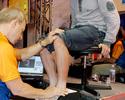
|
|
eSoles says its 'bio-dynamic
pillow'
Photo ©: Jonathan Devich
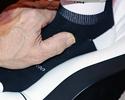
|
|
Our eSoles footbeds
seemed to work as advertised
Photo ©: Mark Zalewski
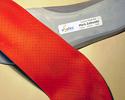
|
|
The quality of the interface between the foot and shoe is critical
in insuring comfort in the cycling experience, but generic insoles
aren't always well suited to a particular anatomy. eSoles says its
custom EVA footbeds not only insure comfort, but also help to realign
a cyclist's biomechanics for a more efficient pedaling stroke and
increased power output. Riders such as George Hincapie, Levi Leipheimer,
and Dave Zabriskie have ridden with eSoles and swear by them, but
their supposed benefits should help anyone.
eSoles' 3D TruCapture technology sits at the heart of the design
process, which begins by placing the rider's foot on a 'bio-dynamic"
pillow of air. eSoles says this yields a truly neutral representation
of your foot unlike other methods that rely on a standing or pressure-laden
position. A laser scan then produces an accurate 3D representation
of the bottom of the rider's foot. eSoles' technicians use that
scan to CNC-machine a rough footbed which is then finished by hand
and covered with the final material.
Obviously, this is not a process that is done over the phone --
but eSoles has a number of scanner-equipped dealers across the country,
as well as representatives that routinely hold clinics throughout
the year. From start to finish, riders can receive their insoles
in about two weeks.
Our test footbeds actually arrived in about a week and were immediately
inserted into a pair of cycling shoes that we previously found to
generally perform quite well with the exception of some occasional
hot spots on longer rides. To address this, our custom insoles included
a metatarsal 'button' that is designed to spread out the bones in
your forefoot and relieve nerve pressure. As small a detail as it
sounds, we're happy to say that it did the trick: within just one
ride this problem disappeared completely. Hallelujah!
Our tester has also suffered some biomechanical issues in the past
due to high arches and oversupination (a tendency to walk on the
outside of the foot). After a year of testing, our eSoles footbeds
did seem to improve foot alignment throughout the entire pedal stroke.
While we can't say with certainty that we were able to crank out
more power as a result, our usual knee, ankle, and hip issues didn't
pop up anymore, either. eSoles has different footbeds for specific
applications, but our test set also did duty in street shoes and
we found them to be just as helpful .
There is the possibility of sticker shock when first considering
purchasing a pair, since their cost is on par with many cycling
shoes. However, our eSoles footbeds have held up well throughout
the test period, and the discomfort one can avoid with proper foot
alignment makes this a worthwhile investment. eSoles also keeps
scans on file, making reorders for replacement or additional specific
footbeds easier and cheaper. /MZ
Price: US$30 (initial scan); US$249 (initial pair of footbeds);
US$219 (additional footbeds)
Pros: Eliminated foot pain problems across variety of shoes,
truly custom fit
Cons: Hefty price is tough to swallow
Cyclingnews rating: 
PhotographyFor a thumbnail gallery of these images, click here
Images by
Jonathan Devich/epicimages.us
Images by
Mark Zalewski/Cyclingnews.com

|










